10 Smart Tips: Hot Tub in Winter Outside Safely and Comfortably
Using a hot tub outdoors in winter feels incredible, warm water against cold air creates a soothing contrast that eases muscle tension and boosts circulation.
Just ensure the tub is well-insulated, the water temperature stays around 100–104°F, and you cover it when not in use to keep heat in and snow or debris out.
❄️ 10 Essential Winter Hot Tub Tips
Proper preparation ensures a relaxing hot tub experience even in freezing weather. Follow these expert recommendations:
1. Invest in a Good Cover
A high-quality, insulated cover retains heat and protects from snow/ice buildup.
2. Monitor Water Level
Keep water above the filter to prevent pump damage and freezing.
3. Maintain Water Cleanliness
Regularly skim and balance chemicals to prevent winter water issues.
4. Change Water Early
Refresh water before winter to ensure cleanliness and chemical balance.
5. Reduce Jet Usage
Turn down jets during extreme cold to prevent system strain.
6. Manage Soak Times
Limit soaking duration to prevent overheating in cold weather.
7. Stay Hydrated
Drink water before/after use to combat winter dehydration.
8. Prepare Your Exit
Keep warm towels and robes nearby for when you get out.
9. Vacation Prep
Set timers or use a secure cover when away during winter.
10. Enhance Your Space
Add lighting and comfort features for a cozy winter oasis.
! Remember: Consistent winter maintenance prevents costly repairs and extends your hot tub’s lifespan.
Winter Hot Tub Tips: Keep It Cozy, Avoid Freezing
Nothing beats sinking into a hot tub when it’s snowing, trust me. But a 2023 spa survey found 25% of owners face winter freeze-ups because they skipped basic prep. The key? Focus on insulation, keep that heater humming, and don’t skimp on a good cover. Here’s how to make your hot tub a year-round haven without breaking the bank.
Prevent Freezing: Protect Your Hot Tub
Cold weather can be brutal on hot tubs, especially if temps dip below 32°F. My buddy learned this the hard way when his pipes froze after a week of neglect. To avoid that mess:
- Insulate Well: Check that your hot tub’s insulation (usually foam) is intact. Add an insulating blanket under the cover for extra protection in places like Minnesota.
- Run the Pump: Keep water circulating to prevent freezing. Most modern tubs, like Hot Spring Spas models, have auto-circulation modes.
- Use a Quality Cover: A thick, well-fitted cover (4-6 inches) traps heat. Replace it if it’s cracked or waterlogged, around $300-$500.
Manage Energy Costs: Stay Warm, Save Money
Nobody wants a $200 electric bill just for a few soaks. My first winter with a hot tub taught me to get smart about energy. Try these:
- Lower the Temp: Set it to 98-100°F instead of 104°F when not in use. Saves about 10-15% on energy, per industry estimates.
- Use a Timer: Run the heater during off-peak hours if your utility offers lower rates. Check with your provider in cities like Denver.
- Winterize if Idle: Going on vacation? Drain and winterize to avoid running costs, roughly $100 for a pro to do it right.
Maintenance Tips for Winter
A little TLC keeps your hot tub purring. Skimp on this, and you’re asking for trouble.
- Check the Heater: Test it before winter hits. A faulty heater can cost $200-$600 to fix, so don’t wait.
- Monitor Water Chemistry: Cold weather messes with pH. Test weekly and adjust, aiming for 7.2-7.8 pH, to avoid corrosion.
- Clear Snow and Ice: Shovel around the tub to prevent snow buildup, which can stress the cover or frame.
Quick Winter Hot Tub Checklist
- Insulate tub and pipes, add a blanket.
- Keep water circulating, check pump.
- Use a thick, snug cover.
- Lower temp to 98°F when idle.
Your hot tub can be a winter game-changer, like mine was during a snowy Chicago January. For more setup tips, check our hot tub deck guide. Grab a hot cocoa and enjoy those cozy soaks all season long.
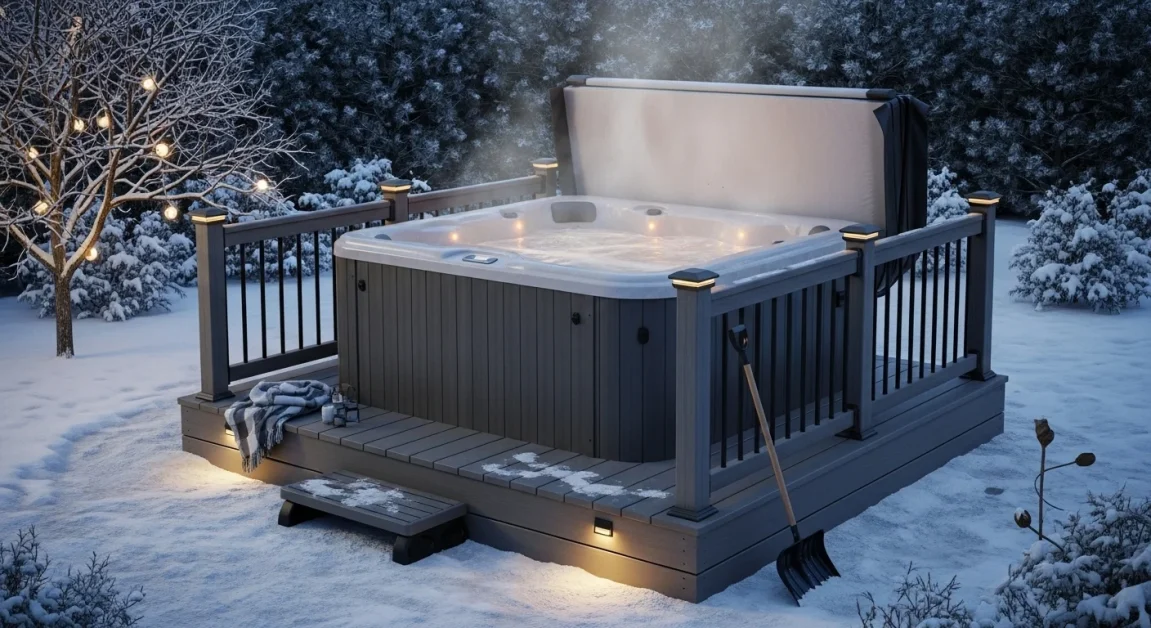
Can I Use My Hot Tub in Winter?
Yes, You Can Use Your Hot Tub in Winter, Here’s How to Make the Most of It
Using your hot tub in the winter is not only possible, but it can also be an incredibly rewarding experience. The key is to keep the water temperature consistent, ideally between 100-104°F, and ensure your tub is well-insulated with a high-quality cover.
Maintaining your hot tub properly during the colder months will prevent freezing pipes and other common issues.
By staying on top of maintenance and adding a few extra comforts like warm towels and outdoor lighting, you can enjoy relaxing soaks even in the chilliest weather.
Should You Drain Your Hot Tub in Winter?
Whether to drain your hot tub in winter depends on your plans. If you’ll be using it regularly, it’s better to keep it filled and running to prevent freezing and damage. On the other hand, if you’re not using it during the colder months, draining and winterizing is a smart move.
This involves fully draining the tub, blowing out the pipes, adding antifreeze, and securing the cover to protect against freezing temperatures. If you decide to keep the tub running, just ensure proper maintenance to keep everything in working order.
Can You Leave a Hot Tub Outside in Winter?
Yes, you can leave a hot tub outside in winter, with the right precautions, like using a quality cover, managing ice buildup, and maintaining the water temperature, leaving your hot tub outside in winter is not only possible but also enjoyable. Just remember to stay on top of maintenance to ensure your hot tub stays in peak condition all season long.
Protecting Your Hot Tub from Winter Weather
- Invest in a High-Quality Cover: A thick, well-insulated cover is your first line of defense against cold weather. It helps retain heat and protects your tub from snow, ice, and debris. Consider adding a thermal blanket underneath the cover for extra insulation.
- Regularly Check for Ice Buildup: Ice can form around the edges of your hot tub or on the cover, adding unnecessary weight and potentially causing damage. Make it a habit to clear away any ice or snow after a storm.
- Use a Windbreak: If your hot tub is in a windy area, a windbreak can help reduce heat loss. This could be as simple as setting up a privacy screen, planting tall shrubs, or even building a small enclosure around the tub.
- Maintain Water Temperature: Keeping the water temperature consistent (ideally between 100-104°F) helps prevent freezing. Running the pump continuously or on a timer will also circulate the water and keep it from freezing in the pipes.
Managing the Risks
Leaving your hot tub outside in winter does come with some risks, primarily the potential for freezing pipes and increased energy costs. To mitigate these risks, make sure to regularly monitor your hot tub’s condition and perform necessary maintenance. Keeping the tub running consistently, with the right water temperature and chemical balance, will minimize the chance of freezing.
What is the Best Temperature for a Hot Tub in Winter?
The best temperature for your hot tub in winter is between 100-104°F. This range provides the perfect balance of warmth and safety, ensuring you can enjoy your hot tub to the fullest even in the coldest weather. Regularly monitoring and maintaining your hot tub’s temperature, along with using a high-quality cover, will help you keep things running smoothly all winter long.
Why Temperature Matters
- Comfort and Enjoyment: A hot tub that’s too cold won’t provide the warmth and relaxation you’re seeking, especially in winter. On the flip side, if it’s too hot, you risk overheating, which can be uncomfortable and even dangerous.
- Preventing Freezing: Keeping the water temperature within this range also helps prevent the water from freezing, particularly in the pipes and jets. Consistent heat circulation is crucial during the colder months.
- Energy Efficiency: While maintaining a higher can increase energy consumption, it’s a necessary trade-off in winter to avoid freezing. You can offset this by ensuring your hot tub is well-insulated and covered when not in use.
Tips for Maintaining the Right Temperature
- Use a Good Cover: A well-insulated cover is essential for retaining heat and reducing energy loss. This also helps in keeping the water temperature stable.
- Monitor the Temperature Regularly: Check your hot tub’s thermostat regularly to ensure it’s holding the correct. If you notice fluctuations, it might be a sign that your heater or insulation needs attention.
- Adjust for Personal Preference: While 100-104°F is the recommended range, some people prefer slightly lower or higher. Just be cautious not to exceed 104°F, as it can pose health risks, especially during prolonged use.
How Do I Protect My Hot Tub in Winter?
keep your hot tub covered, insulated, and running smoothly to protect it from winter weather and ensure it remains in top condition.
- Use a High-Quality Cover: A durable cover helps retain heat and keeps out debris.
- Insulate the Hot Tub: Add extra insulation if needed to prevent freezing.
- Maintain Consistent Temperature: Keep the water between 100-104°F to avoid freezing.
- Check for Ice and Snow: Regularly remove ice and snow from the cover and surrounding area.
- Run the Pump Regularly: Ensure water circulates to prevent freezing in pipes and jets.
- Protect the Equipment: Use a weather-resistant enclosure for the equipment.
- Monitor Water Chemistry: Adjust chemicals regularly to maintain water quality.
Step-by-Step Guide to Use
Use with these simple steps to enjoy your outdoor hot tub:
Before You Dip
- Prepping the Path: Shovel and salt the path to your hot tub to prevent slipping.
- Cover Clear Out: Remove snow and debris from the cover to maintain heat.
- Heat it: Set the temperature to 104°F (40°C) to stay cozy.
- Gear Up: Wear a robe, hat, and slippers; keep a towel nearby.
Soaking in Splendor
- Slow Transition: Gradually adjust to the cold air as you approach the hot tub.
- Ease In: Lower yourself slowly into the warm water.
- Hydration Hero: Drink water to stay hydrated in the cold.
- Jet Joy: Adjust jets for comfort and muscle relief.
- Time Out: Limit soaks to 15-20 minutes in extreme cold.
Post-Soak Savvy
- Dry Off: Wrap up in a robe and towel off to stay warm.
- Warm Up: Head inside for a warm drink and extra layers.
- Cover Up: Secure the cover to protect against snow and keep heat in.
Bonus Tips
- Consider a Gazebo: For added protection from the elements.
- Use a Thermometer: To monitor water temperature.
- Watch the Weather: Adjust usage for extreme cold.
Bonus Tips:
- Consider a gazebo or windbreak for added protection from the elements.
- Invest in a hot tub thermometer to monitor water temperature accurately.
- Monitor weather forecasts for extreme cold snaps and adjust your hot tub usage accordingly.
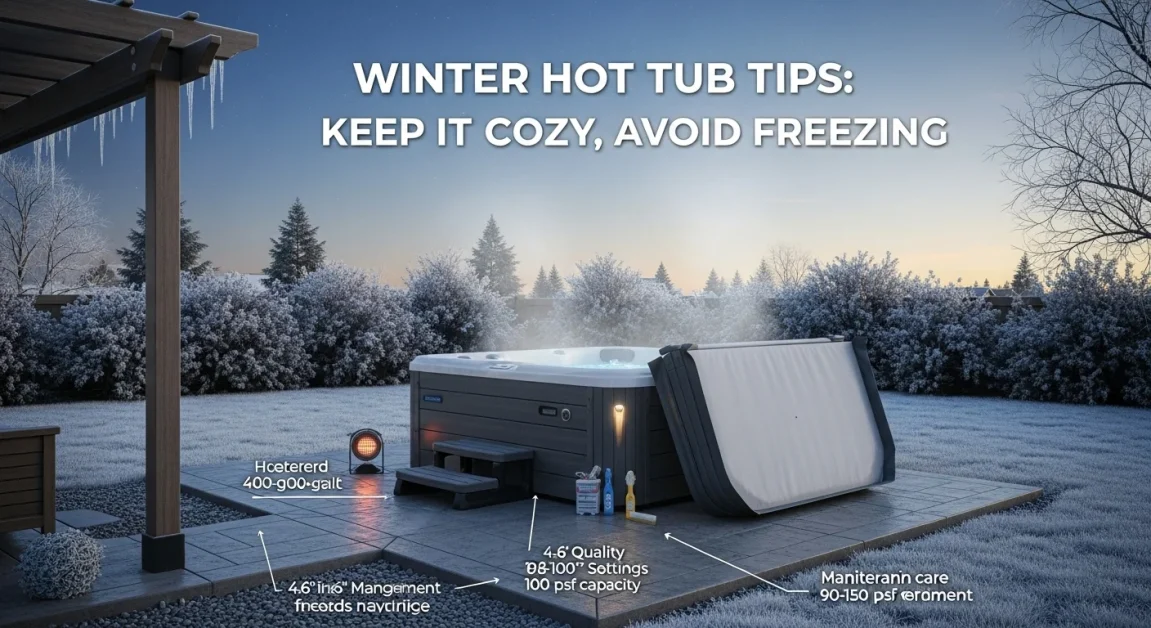
❄️ Can You Get Sick From a Winter Hot Tub?
Hot tubs aren’t just for summer – they can be enjoyed year-round. Modern inflatable hot tubs are perfect for winter months, using water as a heat source that naturally loses some warmth as it circulates.
→ To minimize heat loss, use a spa cover or thermal swimsuit. This provides an enjoyable way to stay warm while preventing rapid temperature drops that could lead to discomfort.
⚠️ Will Your Hot Tub Freeze Overnight?
Generally NO – if properly maintained. Keeping your hot tub filled, covered, and running will prevent freezing even in cold weather.
Built-in Protections:
- Continuous water circulation
- High-quality insulation
- Automatic freeze protection
When Freezing Occurs:
- When tub is drained
- During power outages
- With damaged insulation/cover
🛡️ Recommended Winterizing Kits
Proper winterization prevents costly damage and extends your hot tub’s lifespan. These top-rated kits help:
In The Swim Pool Closing Kit
BioGuard Arctic Blue Kit
Spa Marvel Freeze & Forget
AquaDoc Pool Closer
💡 Pro Tip: Always check your manufacturer’s recommendations for specific winter care instructions.
Should I Leave My Hot Tub Pump On All the Time?
Leaving the hot tub pump on all the time can prevent freezing and maintain a consistent temperature but may increase energy costs. Use a timer or run the pump continuously based on your usage and budget needs.
Benefits of Running the Pump Continuously
- Prevents Freezing: A continuously running pump helps keep the water moving, which prevents the pipes and jets from freezing.
- Ensures Consistent Temperature: Regular circulation helps maintain a stable water temperature, reducing heat loss and avoiding temperature fluctuations.
Considerations for Energy Use
- Higher Energy Costs: Running the pump all the time can increase your energy bills.
- Energy-Saving Options: Consider using a timer to run the pump periodically, balancing the need for prevention with cost efficiency.
Recommendations
- For Frequent Use: If you use your hot tub often, running the pump continuously is generally recommended to keep everything functioning properly.
- For Infrequent Use: If you use the hot tub less frequently, using a timer or adjusting the pump settings can help manage energy costs while still preventing freezing.
Can I Use My Hot Tub If It’s Snowing?
Yes, you can use your hot tub while it’s snowing, using your hot tub while it’s snowing is perfectly fine as long as you manage snow accumulation and maintain the water temperature. Regular maintenance and safety precautions will help you enjoy your hot tub even in snowy weather.
Key Considerations
- Clear Snow from the Area: Shovel or brush off any snow from the hot tub cover and surrounding area to prevent slips and ensure easy access.
- Monitor Snow Accumulation: Excessive snow on the cover can add weight and potentially damage it. Regularly remove snow to keep the cover in good condition.
- Check Temperature Regularly: Ensure the water temperature remains within the ideal range (100-104°F) as snow and cold weather can affect heat retention.
Enjoying the Experience
- Prepare for Cold: Dress warmly and have a towel or robe handy for when you exit the tub. The contrast between the cold air and warm water can be invigorating.
- Stay Safe: Be cautious of icy conditions around the hot tub area to avoid slipping.
Can I Add Snow to My Hot Tub to Refill the Water?
Avoid adding snow to your hot tub for refilling. Instead, use clean water and regularly check the water level to maintain optimal conditions for your hot tub.
Reasons to Avoid Adding Snow
- Potential Contaminants: Snow can carry contaminants and pollutants from the air, which can affect water quality and potentially damage your hot tub’s components.
- Water Chemistry Issues: Snow can introduce impurities and disrupt the balance of chemicals in your hot tub, leading to potential water quality problems.
- Temperature Concerns: Adding snow could rapidly lower the water temperature, which may put extra strain on the hot tub’s heating system and affect overall performance.
Recommended Alternatives
- Use Clean Water: Refill your hot tub with clean, fresh water from a garden hose or other reliable source.
- Regularly Check Water Levels: Ensure the water level is consistently monitored and adjusted as needed to maintain proper operation.
The Benefits of Soaking in the Hot Tub During Winter
Winter hot tubbing provides warmth, social opportunities, and therapeutic relief, making it a valuable addition to your winter routine. Embrace the cold with a cozy soak and enjoy the season to the fullest.
Key Benefits
- Stay Warm Outside While It’s Cold: Enjoying a hot tub provides a comforting contrast to the chilly outdoor temperatures, helping you stay warm and relaxed.
- Winter Socializing and Celebrations: A hot tub can be a great gathering spot for winter celebrations, allowing you to socialize and enjoy the season with friends and family.
- Cold Weather Hydrotherapy: Warm water can soothe sore muscles and joints, offering therapeutic benefits that are especially comforting during cold weather.
NOTE
Remember to keep your filtration system in good working order, remove any snow from around the cover periodically, and maintain proper water levels for optimal usage.
❄️ Winter Hot Tub Dos & Don’ts
Follow these essential tips to enjoy your hot tub safely and comfortably all winter long.
✓ Dos
- Wear a Toque: Retains body heat while soaking
- Wear Sandals: Protect feet from cold surfaces
- Open Waterfall Valves: Prevent freezing
- Lock Your Cover: Keep snow/debris out
- Turn Air Controls Off: Reduce system stress
✗ Don’ts
- Change Water in Extreme Cold: Strains the system
- Use Snow to Refill: Introduces contaminants
- Use a Shovel on Cover: Can cause damage
- Neglect Maintenance: Prevents freezing issues
- Skip Regular Checks: Essential for winter operation
⚠️ Winter Soaking Attire
Want More Winter Care Tips?
Read Complete Winter Care GuideExpert advice to keep your hot tub running smoothly all season
🔍 Want more info? Head over to Hot Tub Patio 🛁 or check our Guides 📖 for extra reading!
FAQs

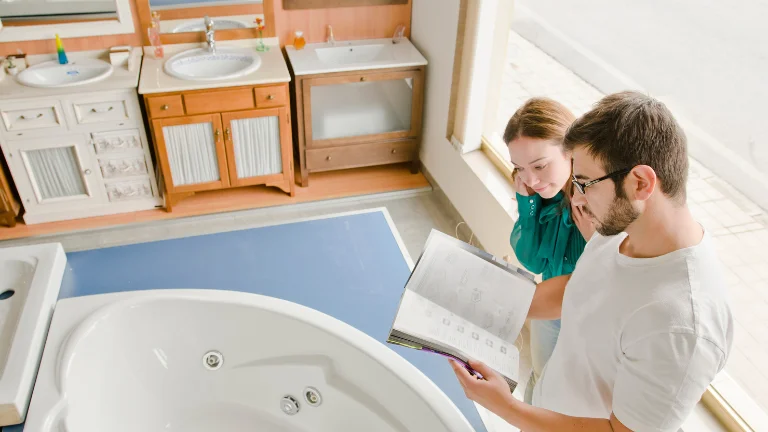






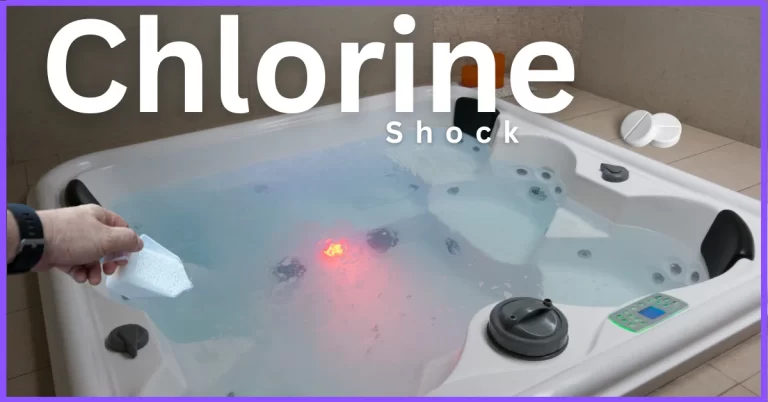
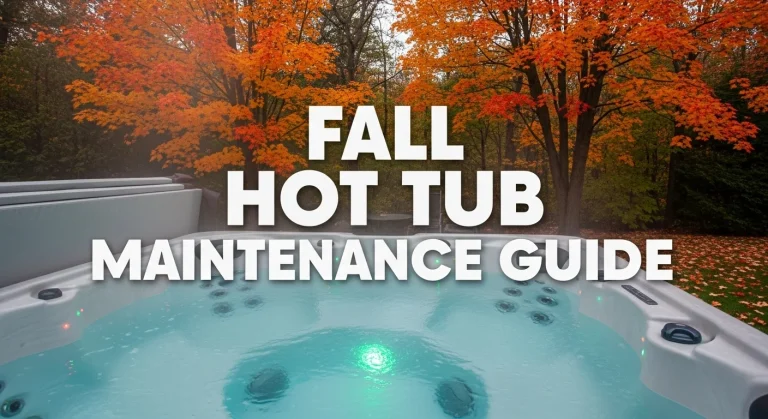
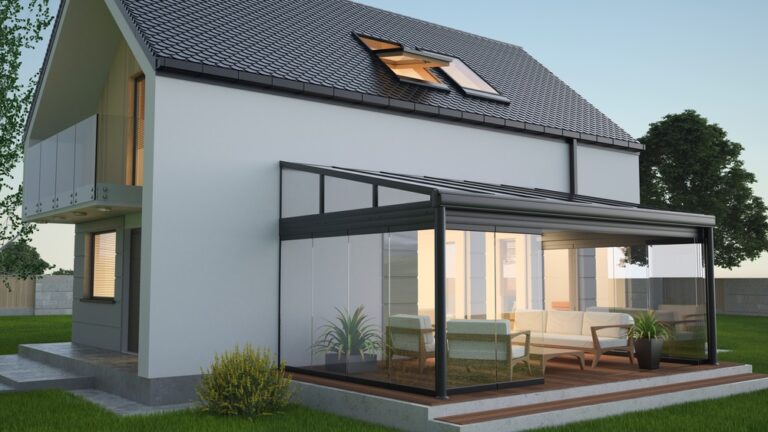

5 Comments